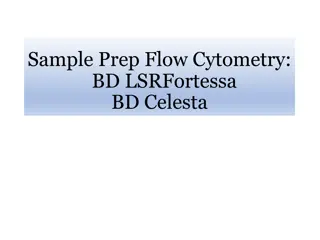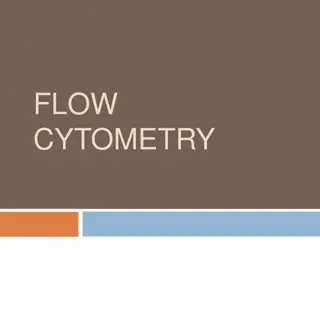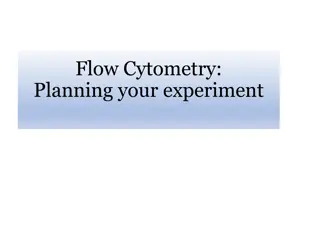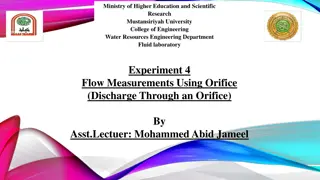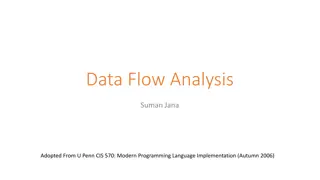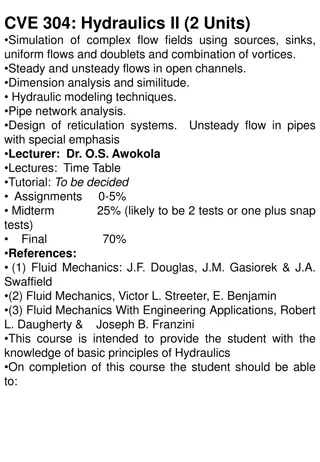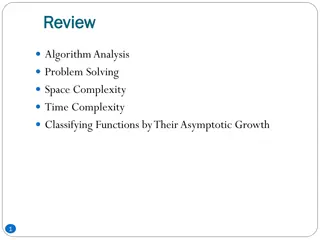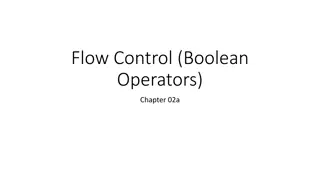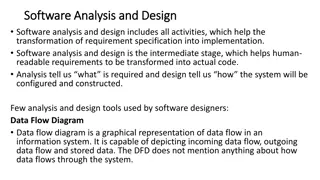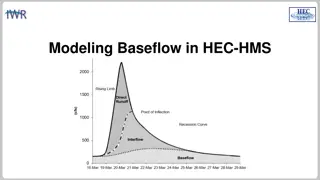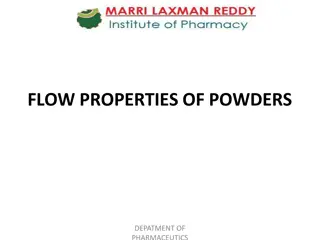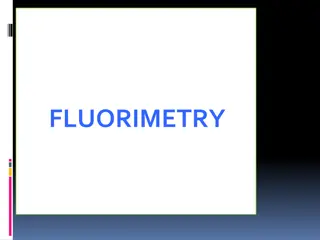Understanding Flow Cytometry: Principles and Applications
Flow cytometry is a powerful technology used to analyze the properties of cell populations. By measuring size, complexity, and fluorescence intensity, this method provides valuable insights into various biological samples. The process involves labeling cells with fluorescent markers, passing them through a laser beam for activation, and detecting emitted light for analysis. With its ability to quantify and qualify cellular characteristics, flow cytometry is widely used in fields such as hematology, immunology, and oncology.
Download Presentation

Please find below an Image/Link to download the presentation.
The content on the website is provided AS IS for your information and personal use only. It may not be sold, licensed, or shared on other websites without obtaining consent from the author. Download presentation by click this link. If you encounter any issues during the download, it is possible that the publisher has removed the file from their server.
E N D
Presentation Transcript
FLOW CYTOMETRY
FLOW CYTOMETRY Definition: Measuring properties of cell as they flow in a fluid suspension across an illuminated light path.
Basic mechanism Biological sample Label it with a fluorescent marker Cells move in a linear stream through a focused light source (laser beam) Fluorescent molecule gets activated and emits light that is filtered and detected by sensitive light detectors (usually a photomultiplier tube) Conversion of analog fluorescent signals to digital signals
Flow Cytometry This qualitative analysis of several properties of cell populations from virtually any type of fresh unfixed tissue or body fluid. method allows the quantitative and The properties measured include a particle s related size, relative complexity, and relative fluorescence intensity granularity or internal Most commonly analyzed materials are: blood, bone marrow aspirate and lymph node suspensions.
Principle of Flow Cytometry Flow cytometer is composed of three main components: The Flow system (fluidics) Cells in suspension are brought in single file past The Optical system (light sensing) a focused laser which scatter light and emit fluorescence that is filtered and collected The Electronic system (signal processing) emitted light is converted to digitized values that are stored in a file for analysis
The Flow System One of the fundamentals of flow cytometry is the ability to measure the properties of individual particles, which is managed by the fluidics system. When a sample is injected into a flow cytometer, it is ordered into a stream of single particles. The fluidic system consists of a FLOW CELL(Quartz Chamber): Central channel/ core - through which the sample is injected. Outer sheath - contains faster flowing fluid k/a Sheath fluid (0.9% Saline / PBS) , enclosing the central core.
Hydrodynamic Focusing Once the sample is injected into a stream of sheath fluid within the flow chamber, they are forced into the center of the stream forming a single file by the PRINCIPLE OF HYDRODYNAMIC FOCUSING. 'Only one cell or particle can pass through the laser beam at a given moment.'
The sample pressure is always higher than the sheath fluid pressure, ensuring a high flow rate allowing more cells to enter the stream at a given moment. High Flow Rate - Immunophenotyping analysis of cells Low Flow Rate - DNAAnalysis Sample Tube Sample Pressure (Variable) Sheath Pressure (Constant) Waste T ank Sheath T ank Vacuum Line Pressure
OPTICS After the cell delivery system, the need is to excite the cells using a light source. The light source used in a flow cytometer: Laser (more commonly) Arc lamp Why Lasers are more common? They are highly coherent and uniform. They can be easily focused on a very small area (like a sample stream). They are monochromatic, emitting single wavelengths of light. ARGON Lasers - 488nm wavelength (blue to blue green)
When a light intersects a laser beam at the so called 'interogation point' two events occur: a) light scattering b) emission of light (fluorescence ) Fluorescence is light emitted during decay of excited electron to its basal state.
OPTICS a) LIGHT SCATTER When light from a laser interrogates a cell, that cell scatters light in all directions. The scattered light can travel from the interrogation point down a path to a detector.
OPTICS - FORWARD SCATTER (FSC) Light that is scattered in the forward direction (along the same axis the laser is traveling) is detected in the Forward Scatter Channel. The intensity of this signal has been attributed to cell size, refractive index (membrane perm eability).
OPTICS - SIDE SCATTER (SSC) Laser light that is scattered at 90 degrees to the axis of the laser path is detected in the Side Scatter Channel. The intensity of this signal is proportional to the amount of cytosolic structure in the cell (eg. granules, cell inclusions, etc.) Side scatter detector Measuring cell granularity
FSC Detector Laser Beam Collection Lens SSC Detector
Why FSC & SSC? Granulocytes Lymphocytes SSC Monocytes RBCs, Debris, Dead Cells FSC Study of FSC and SSC allows us to know the differentiation of different types of cells.
The light is proportional to the square of the radius of a sphere, and so to the size of the cell or particle. scattered in the forward direction The antibodies cytoplasmic or nuclear dye. cells are or labelled stained with fluorescent fluorochrome-linked membrane, with
Commonly used Fluorochromes FLUOROCHROMES EMISSION MAXIMUM Fluorescein Isothiocynate (FITC) 530nm Phycoerythrin (PE) 576nm Peridin-chlorophyll alpha complex (PerCP) 680nm Allophycocyanin (APC) 660nm T exas red 620nm ECD( PE - T exas Red T andem) 615nm PC5 (PE - cyanin 5 dye tandem) 667nm
Optics B) EMISSION OF FLUORESCENT LIGHT (FLUORESCENCE) As the fluorescent molecule present in or on the particle is interrogated by the laser light, it will absorb energy from the laser light and release the absorbed energy at longer wave length. Emitted photons pass through the collection lens and are split and steered down specific channels with the use of filters.
Optics- Filters Different wavelengths scattered simultaneously from a cell Need to split the light into its specific wavelengths in order to measure and quantify them independently. This is done with filters. of light are The system of filters ensures that each photodetector receives light bands of various wavelengths. are designed such that they absorb or wavelengths of light, while transmitting Optical filters reflect some others. Types of filters 1. Long Pass 3. Band Pass 2. Short Pass 4. Dichroic
Optics- Long Pass Filters Transmit all wavelengths greater than specified wavelength Example: 500LP will transmit all wavelengths greater than 500nm Transmittance 400nm 700nm 600nm 500nm Original from Cytomation Training Manual
Optics- Short Pass Filter Transmits all wavelengths less than specified wavelength Example: 600SP will transmit all wavelengths less than 600nm. Transmittance 400nm 700nm 600nm 500nm Original from Cytomation Training Manual
Optics- Band Pass Filter Transmits a specific band of wavelengths Example: 550/20BP Filter will transmit wavelengths of light between 540nm and 560nm (550/20 = 550+/- 10, not 550+/-20) Transmittance 400nm 700nm 600nm 500nm Original from Cytomation Training Manual
Optics- Dichroic Filters Long pass or short pass filters Placed at a 45 angle of incidence Part of the light is reflected at 90 , and part of the light is transmitted and continues. Detector 1 Detector 2 Dichroic Filter
OPTICS - DETECTORS The photodetectors convert the photons to electrical impulses. Two common types of detectors used in flow cytometry: Photodiode used for strong signals, when saturation is a potential problem (eg, forward scatter detector). Photomultiplier tube (PMT) more sensitive than photodiode but can be destroyed by exposure to too much light. used for side scatter and fluorescent signols.
ELECTRONICS The electronic subsystem converts photons to photoelectrons. Measures amplitude, area and width of photoelectron pulse. It amplifies pulse either linearly or logarithmically and then digitalizing the amplified pulse.
DataAnalysis- Plot Types There are several plot choices: Single Color Histogram Fluorescence intensity (FI) versus the number of cells counted. Two Color Dot Plot FI of parameter 1 versus FI of Parameter 2 Two Color Contour Plot Concentric rings form around populations. The more dense the population, the closer the rings are to each other Two Color Density Plot Areas of higher density will have a different color than other areas
Plot Types Density Plot Contour Plot Histogram Greyscale Density Dot Plot www.treestar.com
DATAANALYSIS - GATING Gating is in essence electronic window that sets upper and lower limits on the type and amount of material that passes through. Selection of only a certain population of cells for analysis on a plot. Allows the ability to look at parameters specific to only that subset.
Interpretation of Graphs An important tool for evaluating data is the dot plot. The instrument detects each cell as a point on an X-Y graph. This form of data presentation looks at two parameters of the sample at the same time.
Three common modes for dot plots are: Forward scatter (FSC) vs. side scatter (SSC) To look at the distribution of cells based upon size & granularity Single color vs. side scatter To visualize the expression of the fluorescence of the cells Two-color fluorescence plot. To differentiate between those cells that express only one of the particular fluorescent markers, those that express neither, and those that express both. used to discriminate dead cells from the live ones that are expressing the desired fluorescence.
How to differentiate dim & bright expression of an antigen? Dim : cells are present more towards the origin(0) on x(red) - y axis (pink) BRIGHT DIM Y-axis CD4 Bright : cells are present away from the origin(0) on x(green) & y(yellow) axis. X-axis CD8
WHAT IS UNIQUE IN FLOWCYTOMETRY MULTIPARAMETRIC RAPIDANALYSIS OF LARGE NUMBER OF CELLS INFORMATIONATASINGLE CELL LEVEL DETECTION OF RARE CELLPOPULATIONS ALLOWS PHYSICAL ISOLATION OF CELLS OF INTEREST
USES OF FLOWCYTOMETRY
APPLICATIONS ANALYSIS Immunophenotyping Dyes that bind to nucleic acids (DNA, RNA) Functional assays CELLCOUNTING CELLSORTING
CLINICALAPPLICATIONS Absolute CD4 counts HIV/AIDS HLAB27 assay Joint Pain Hematological Malignancies Diagnosis and Classification Detection of MRD DNAPloidy S Phase fraction Solid Tumours Primary TBNK Phagocytic function defect Immunodeficiency disorders
Cont.. Reticulocyte count PNH Osmotic fragility assay Hemolytic anaemia Feto- maternal Hemorrhage treatment response in Sickle CellAnemia Fetal Hb detection Platelet receptor assays (Platelet count, GT , BSS) Platelet function assay (CD62P , PAC-1) Bleeding Disorders Transfusion and Transplant CD34 STEM CELLCOUNTS Residual WBC count in leukodepleted blood packs Flow cytometry Crossmatch Surface markers in PMN, Monocytes Cytokine response Host Immune response in Sepsis
References THE FLOW CYTOMETRIC EVALUATION OF HEMATOPOIETIC NEOPLASIA Brent L. Wood, Michael J. Borowitz. Henry s, 22nd edition, Chapter 34 https://www.bosterbio.com/protocol-and-troubleshooting/flow- cytometry-principle https://www.abcam.com/protocols/introduction-to-flow-cytometry Video Link: https://www.youtube.com/watch?v=5IdYFgYb9ls https://www.youtube.com/watch?v=7bCZx5xPwt0&t=94s


